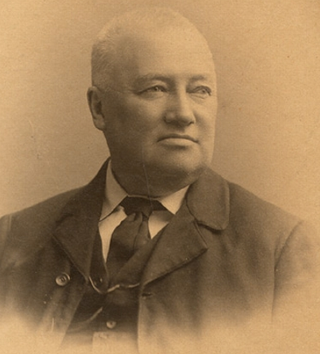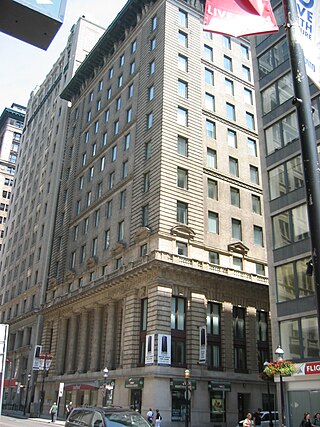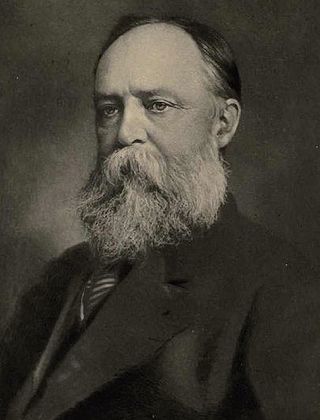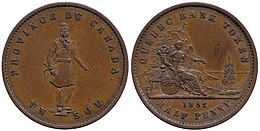
The Bank of Montreal is a Canadian multinational investment bank and financial services company.

Ernest CormierOC was a Canadian engineer and architect. He spent much of his career in the Montreal area, designing notable examples of Art Deco architecture, including the Université de Montréal original main building, the Supreme Court of Canada Building in Ottawa, and the Cormier House.

Royal Bank of Canada is a Canadian multinational financial services company and the largest bank in Canada by market capitalization. The bank serves over 20 million clients and has more than 100,000 employees worldwide. Founded in 1864 in Halifax, Nova Scotia, it maintains its corporate headquarters in Toronto and its head office in Montreal. RBC's institution number is 003. In November 2017, RBC was added to the Financial Stability Board's list of global systemically important banks.

The Molson Bank was a Canadian bank founded in Montreal, Quebec, by brothers William (1793–1875) and John Molson, Jr. (1787–1860), the sons of brewery magnate John Molson.

The Imperial Bank of Canada was a Canadian bank based in Toronto, Ontario, during the late 19th century and early 20th century.

The Canadian Bank of Commerce was a Canadian bank which was founded in 1867, and had hundreds of branches throughout Canada. It merged in 1961 with the Imperial Bank of Canada to form the Canadian Imperial Bank of Commerce.
William Armstrong was a Canadian artist and one of the early professional artists of Toronto, Ontario.

The Bank of British North America was founded by royal charter issued in 1836 in London, England. British North America was the common name by which the British colonies and territories that now comprise Canada were known prior to 1867.

Football Canada is the governing body for gridiron football in Canada headquartered in Ottawa, Ontario. Football Canada focuses primarily its own Canadian form of the sport, and is currently the world's only national governing body for Canadian football.

The Elgin & Winter Garden Theatres are a pair of stacked theatres in Toronto, Ontario, Canada. The Winter Garden Theatre is seven storeys above the Elgin Theatre. They are the last surviving Edwardian stacked theatres in the world.

The Bank of New Brunswick, established in 1820, was the first Canadian bank to operate under a charter. The bank operated independently in New Brunswick and later in Prince Edward Island until it merged with the Bank of Nova Scotia in 1913.

Eugène-Étienne Taché, ISO was a French Canadian surveyor, civil engineer, illustrator and architect. He devised Quebec's provincial coat-of-arms and motto Je me souviens.
Ross and Macdonald was one of Canada's most notable architecture firms in the early 20th century. Based in Montreal, Quebec, the firm originally operated as a partnership between George Allen Ross and David MacFarlane from 1907 to 1912. MacFarlane withdrew from the firm in 1912, and Robert Henry Macdonald became a partner.

Trader's Bank Building is a 15-storey, 55.39 m (181.7 ft) early skyscraper, completed in 1906 at 67 Yonge Street in Toronto, Ontario, Canada. The building was designed by Carrère and Hastings, with construction beginning in 1905. It was the tallest building in the British Commonwealth until the Royal Liver Building was completed in 1911. It remains one of Canada's few surviving skyscrapers of the early 20th Century.

Sir Byron Edmund Walker, CVO was a Canadian banker. He was the president of the Canadian Bank of Commerce from 1907 to 1924, and a generous patron of the arts, helping to found and nurture many of Canada's cultural and educational institutions, including the University of Toronto, National Gallery of Canada, the Champlain Society, Appleby College, Art Gallery of Ontario and Royal Ontario Museum.
The Great Lakes-St. Lawrence Lowlands, or simply St. Lawrence Lowlands, is a physiographic region of Eastern Canada that comprises a section of southern Ontario bounded on the north by the Canadian Shield and by three of the Great Lakes — Lake Huron, Lake Erie and Lake Ontario — and extends along the St. Lawrence River to the Strait of Belle Isle and the Atlantic Ocean. The lowlands comprise three sub-regions that were created by intrusions from adjacent physiographic regions — the West Lowland, Central Lowland and East Lowland. The West Lowland includes the Niagara Escarpment, extending from the Niagara River to the Bruce Peninsula and Manitoulin Island. The Central Lowland stretches between the Ottawa River and the St. Lawrence River. The East Lowland includes Anticosti Island, Îles de Mingan, and extends to the Strait of Belle Isle.
Fascism in Canada consists of a variety of movements and political parties in Canada during the 20th century. Largely a fringe ideology, fascism has never commanded a large following amongst the Canadian people, and it was most popular during the Great Depression. At the outbreak of World War II, most Canadian fascist leaders were interned under the Defence of Canada Regulations and in the post-war period, fascism never recovered its former small influence.

Robert Wilson Reford (1867–1951) was a Canadian photographer, businessman and art collector.

The Middlesex County Court House is a historic building and a National Historic Site of Canada in London, Ontario, Canada. The courthouse building is an "early example of the Gothic Revival style, pre-dating the earliest important Gothic Revival public building in England".

Pedimental sculptures are sculptures within the frame of a pediment on the exterior of a building, some examples of which can be found in Canada. Pedimental sculpture poses special challenges to sculptors: the triangular composition limits the choices for figures or ornament at the ends, and the sculpture must be designed to be viewed both from below and from a distance.
















